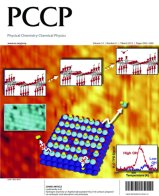Getting Your Catalyst What It Needs
New method creates highly reactive catalytic surface, packed with hydroxyl species
(April 2012)

Artwork from this catalysis research graced the cover of Physical Chemistry Chemical Physics. Image reproduced by permission of Dr Igor Lyubinetsky and the PCCP Owner Societies from Phys. Chem. Chem. Phys. 2012. 14(9):3066-3074. DOI:10.1039/c1cp22515d
Enlarge Image
Results: To do its job, the popular catalyst titanium dioxide often needs an even layer of hydroxyl groups across its surface; thanks to a new method by scientists at Pacific Northwest National Laboratory, the catalyst is now getting it. A hydroxyl group is a hydrogen atom bonded to an oxygen atom. In the case of the catalyst, the oxygen is a part of the material structure. It just needs a hydrogen atom. The team's new method covers about 50 percent of the surface with hydroxyl groups.
In addition, the team found that the hydrogen atoms on the surface didn't migrate inside the material when the catalyst is heated. The hydrogen atoms combine with the catalyst's lattice oxygen to create water. Images from PNNL's study grace the March 7, 2012, cover of Physical Chemistry Chemical Physics.
Why It Matters: The titanium-based catalysts use light to split water into oxygen and hydrogen, to synthesize or degrade various organic molecules and for many other applications including fuel cells, solar cells and other devices. To take these materials to the next step demands knowledge-based design and modification of their surface, which is a key in the catalytic process. Surface hydroxyl groups play a crucial role here for achieving both peak performance and market values.
"Understanding reactivity of hydrogen atoms on this unique highly hydroxylated surface of titania was an important part of this work," said Dr. Nikolay Petrik, one of the key researchers on this project, a scientist at the Institute for Integrated Catalysis at Pacific Northwest National Laboratory. "Hydrogen can be produced via photocatalysis using titanium-based materials, and it is stored in a form of surface hydroxyls. Our future goal, a great challenge, is to get these hydrogen atoms working, getting them to produce energy."
Methods: Conventional methods for putting hydroxyl groups on titanium dioxide (TiO2) achieve about 20% coverage. The team wanted to beat those results, getting more coverage without resorting to extremes of time, temperatures, or resources. The team turned to a familiar compound: trimethyl acetic acid or TMAA. Over the years, scientists at PNNL have extensively characterized this 9-carbon acid.
The team's approach was a simple two-step process. First, inside a vacuum chamber, the team exposed the titanium dioxide surface to the TMAA. Then, they used a mercury lamp and a bit of fiber optics to shine ultraviolet light on the sample. The light removes the core of the acid molecule leaving just hydrogen atoms attached to the surface.
The team used scanning tunneling microscopy, temperature-programmed desorption, and photo-stimulated desorption techniques at EMSL to characterize the surface. In addition, the team completed density functional theory calculations, using resources at EMSL and the National Energy Research Scientific Computing Center, to fully understand the structure and reactivity of the surface. The team found that new method resulted in half of the oxygen atoms on the surface having hydrogen attached to them, creating hydroxyl groups.
"We achieved good coverage of the surface, 50%, and this technique has promise to go all the way to 100%," said Dr. Igor Lyubinetsky, the lead researcher on the study, a scientist at EMSL and a member of PNNL's Institute for Integrated Catalysis. In addition, the team demonstrated that the hydrogen from the surface does not migrate into the material when it is heated.
What's Next? "Our next step is to achieve a fully hydroxylated surface," said Lyubinetsky. "It should be possible, but we need to verify." The team is researching the thermodynamics, kinetics, and other factors that influence the surface hydroxylation.
Acknowledgments:
Sponsors: This work was supported by the U.S. Department of Energy Office of Basic Energy Sciences, Chemical Science, Geoscience, and Biosciences Division. Upgrades to the STM system used in this research were supported by the American Recovery and Reinvestment Act of 2009.
User Facilities: EMSL and NERSC
Research Team: Yingge Du, Nikolay G Petrik, Zhitao Wang, Michael A Henderson, Gregory A Kimmel and Igor Lyubinetsky, all PNNL, and N Aaron Deskins, formerly with PNNL and now with Worcester Polytechnic Institute
Reference: Y Du, NG Petrik, NA Deskins, Z Wang, MA Henderson, GA Kimmel, and I Lyubinetsky. 2012. "Hydrogen Reactivity on Highly-Hydroxylated TiO2(110) Surfaces Prepared via Carboxylic Acid Adsorption and Photolysis." Physical Chemistry Chemical Physics 14(9):3066-3074. DOI:10.1039/c1cp22515d.
